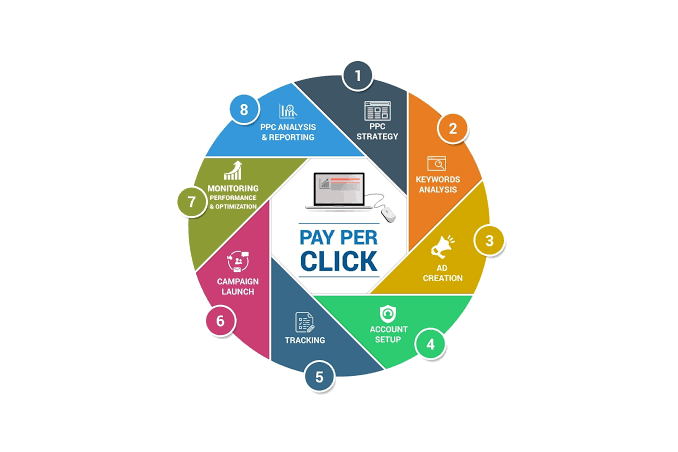In July 2025, digital competition is fiercer than ever. With businesses fighting for attention across search engines and social platforms, Pay-Per-Click (PPC) advertising remains one of the most effective tools for generating targeted traffic and increasing conversions.
Unlike organic marketing, PPC offers instant visibility and measurable results. Whether through Google Ads, Bing Ads, or paid social media campaigns, PPC allows businesses to appear in front of high-intent audiences right when they’re searching.
To maximize ROI, businesses must go beyond simply placing ads. A strong PPC strategy involves research, testing, optimization, and ongoing performance evaluation.
Define Clear Campaign Goals Before Spending
Before launching a PPC campaign, you must identify the exact objective. Are you trying to drive website visits, generate leads, sell a product, or grow brand awareness?
Setting specific goals ensures you choose the right platforms, formats, and bidding strategies. For instance, if your aim is to sell a product, Google Shopping or Amazon Ads may be more effective than a basic display ad.
In 2025, goal-based campaign structures are crucial because machine learning systems used by Google and Meta Ads now optimize better when the algorithm understands your campaign purpose.
Conduct Thorough Keyword Research
Keyword research forms the backbone of any successful PPC strategy. Using the right keywords ensures your ads show up for the terms your audience is actively searching for.
Modern tools like Google Keyword Planner, Ahrefs, and Semrush now include AI features that predict keyword trends and user intent more accurately. Long-tail keywords remain highly valuable for capturing niche audiences at lower costs.
In 2025, voice search and natural language queries are increasingly influencing keyword planning. Optimizing for conversational phrases can give advertisers a competitive edge in both desktop and mobile searches.
Use Compelling Ad Copy and Visuals
Getting clicks is only possible if your ad copy stands out. Your message must be clear, concise, and offer a compelling reason for users to act.
Use action-driven headlines, strong call-to-actions (CTAs), and benefit-focused language. For display or social PPC ads, eye-catching visuals and video content improve click-through rates significantly.
In 2025, AI-assisted ad copy tools like Copy.ai and Jasper help generate and A/B test different versions of copy faster. But human review remains key—authenticity still wins over robotic language.
Optimize Landing Pages for Conversions
Sending users to a generic homepage often leads to lost conversions. Instead, each PPC ad should direct visitors to a landing page that matches the ad’s promise and encourages immediate action.
An optimized landing page includes a focused headline, minimal distractions, clear CTAs, and fast loading speed. Mobile responsiveness is crucial, especially with 70%+ of traffic coming from smartphones in 2025.
Modern platforms like Unbounce and Instapage offer dynamic text replacement, enabling your landing page to reflect the exact keywords or products mentioned in the ad—this technique significantly boosts conversion rates.
Use Targeted Audience Segmentation
Instead of targeting everyone, PPC campaigns perform better when they’re tailored to specific audiences. You can segment by location, device, interests, demographics, or even previous behavior.
Retargeting campaigns allow you to re-engage users who visited your website but didn’t convert. These audiences are often more likely to act when presented with a second, well-timed offer.
In 2025, AI audience modeling allows platforms to create lookalike audiences based on your best-performing customer segments, helping advertisers scale with precision.
Take Advantage of Automation and AI
Most ad platforms now rely heavily on automation and machine learning to optimize bidding, placements, and ad delivery. Using tools like Google Ads’ Smart Bidding or Meta’s Advantage+ can enhance campaign efficiency.
These systems adjust bids in real-time based on user signals like device, location, and time of day. However, it’s important to monitor and adjust automation rules to align with your budget and ROI goals.
While automation simplifies execution, manual oversight is still needed to avoid waste and ensure campaigns stay aligned with your brand message.
Monitor Performance and Adjust Accordingly
A successful PPC campaign is never “set and forget.” Regularly review key metrics such as click-through rate (CTR), cost per click (CPC), conversion rate, and return on ad spend (ROAS).
Use A/B testing to compare headlines, visuals, and landing page formats. In 2025, real-time dashboards provided by platforms like Google Analytics 4, Data Studio, and Tableau allow for granular performance insights.
Performance data should inform your decision-making. Pause underperforming ads, reallocate budgets, and continue testing new variations to stay ahead.
Explore Multi-Platform Advertising Strategies
Limiting your ads to one platform may reduce your reach. A smart 2025 strategy involves advertising across search engines, social media, and e-commerce platforms for broader exposure.
Google Ads work well for search intent, while Meta and TikTok Ads capture attention through storytelling. Amazon PPC is effective for product listings, and LinkedIn Ads work for B2B marketing.
Each platform requires a tailored approach—what works on Instagram may fail on LinkedIn. Understand the audience behavior on each platform and adapt your content and format accordingly.
Track Conversions with Updated Tools
With growing privacy regulations and the phasing out of third-party cookies, conversion tracking has changed. In 2025, tools like Google’s Enhanced Conversions, Facebook’s Conversions API, and server-side tracking are necessary for accurate attribution.
First-party data collection through opt-ins, CRM systems, and email lists now plays a bigger role in tracking and retargeting efforts. Make sure your website is compliant with current privacy laws while still gathering useful behavioral data.
Without proper tracking, it becomes impossible to evaluate which campaigns drive the best results.
Conclusion: PPC as a Smart Investment in 2025
PPC advertising continues to evolve, but its core purpose remains the same—to drive high-intent traffic and increase sales efficiently. With strategic planning, continuous testing, and smart use of technology, it offers one of the fastest routes to digital visibility and revenue growth.
In 2025, successful PPC is all about balancing automation with human strategy. By focusing on user experience, targeting the right audience, and staying data-informed, your campaigns can deliver consistent and scalable results.
Ultimately, PPC isn’t just about clicks—it’s about conversions. And with the right approach, every dollar spent can bring measurable returns.



